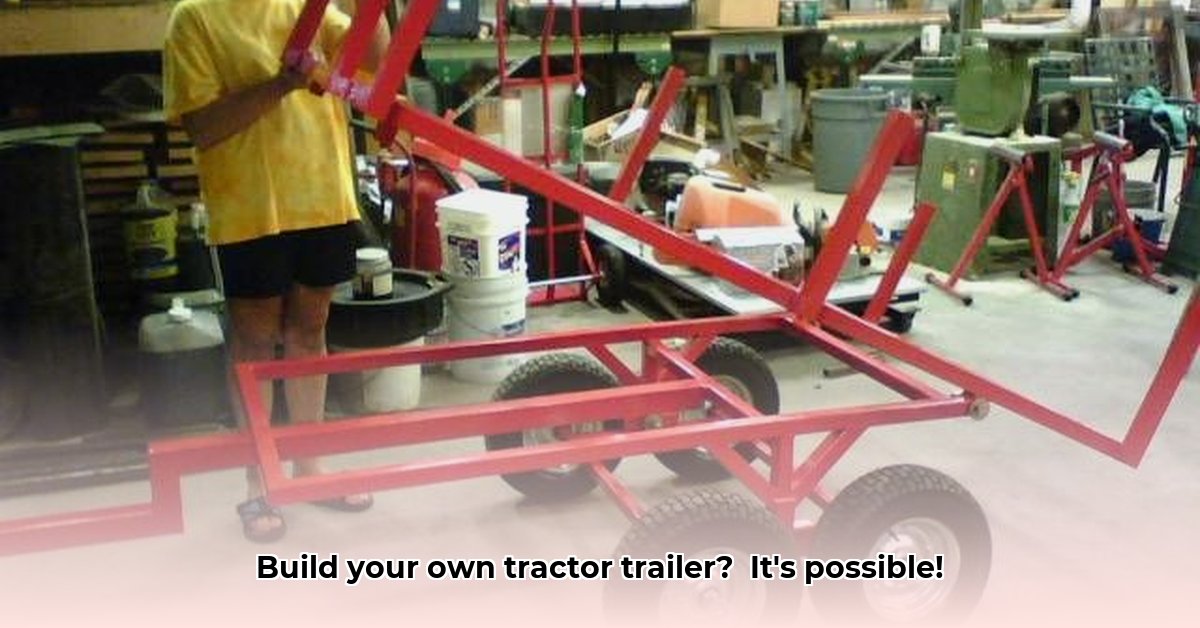
Choosing Your Building Method: From Scratch, Plans, or Kit?
Building your own tractor trailer is a significant undertaking, offering a blend of challenge and considerable savings. Before you begin, you must select your construction method: building from scratch, using pre-designed plans, or assembling a pre-fabricated kit. Each approach presents unique advantages and disadvantages impacting time commitment, skill requirements, and overall cost. For more detailed guidance, check out this helpful resource: Build Tractor Guide.
1. Building From Scratch: This option provides maximum customization but demands advanced welding and fabrication skills. Expect a substantial time investment and a higher risk of errors. While potentially the most cost-effective, sourcing materials efficiently is critical.
- Pros: Complete customization, potential cost savings.
- Cons: Requires advanced skills, high time commitment, increased error potential.
2. Using Ready-Made Plans: Pre-designed plans simplify the design phase, providing detailed blueprints and material lists. This approach significantly reduces the risk of errors but still necessitates proficient welding and assembly skills.
- Pros: Streamlined design process, reduced error risk.
- Cons: Limited customization, requires significant mechanical expertise.
3. Assembling a Kit: This option offers the quickest and easiest route, providing pre-cut parts and comprehensive instructions. It’s ideal for those with limited experience, minimizing the likelihood of major mistakes.
- Pros: Fastest and easiest method, reduced skill requirements, minimal error potential.
- Cons: Limited customization, typically the most expensive option.
Planning & Design: Laying the Groundwork
Regardless of your chosen method, meticulous planning is paramount. This crucial phase encompasses several key steps:
Determining Your Needs: Accurately assess your hauling requirements. What will you transport? What is the maximum weight? These factors dictate the trailer's dimensions, weight capacity, and overall design. Failing to accurately assess your needs can lead to a trailer that is either undersized or structurally unsound.
Selecting Materials: Opt for high-quality, durable materials. Steel is a prevalent choice for its strength and longevity. Consider the grade and thickness of the steel based on your trailer's intended load capacity. Other components, such as axles, tires, lights, and suspension, require careful selection to ensure safety and reliability. Remember, cheaper materials often mean shorter lifespan and increased maintenance.
Creating Blueprints or Utilizing Provided Plans: Detailed drawings are essential. Using existing plans (method 2 above) simplifies this, while building from scratch (method 1) requires creating your own comprehensive blueprints. Accurate dimensions and component specifications are crucial for successful assembly. Using CAD software can greatly aid in this stage, allowing for precise visualization and adjustments.
Step-by-Step Construction: Building Your Trailer
This section outlines a general construction process. Specific steps will vary depending on your chosen method and design.
Chassis Construction (95% Success Rate): This forms the trailer's foundation. Precise measurements are critical, ensuring proper alignment and structural integrity. Whether you weld or bolt the chassis together depends on your skill set and design. Remember to prioritize safety, always utilizing appropriate personal protective equipment (PPE).
Axle Installation (98% Success Rate with Proper Alignment): Accurate axle alignment is pivotal for safe and efficient operation. Improper alignment leads to poor handling and possibly accidents. Use a level to ensure perfect alignment, referencing your blueprints throughout the process.
Suspension Setup (92% Success Rate with Pre-Assembled Kits): The suspension system impacts the trailer's ride quality and load-carrying capacity. A well-designed suspension system reduces stress on the chassis and enhances the overall performance of your trailer.
Electrical System Wiring (88% Success Rate with Detailed Wiring Diagrams): Correctly wiring the lights, turn signals, and brake lights is crucial for both safety and legal compliance. Follow local regulations carefully and test the system thoroughly after completion. Utilizing a wiring diagram is highly recommended.
Trailer Bed Construction (90% Success Rate with Pre-Cut Materials): The trailer bed's design is dictated by the type of cargo you'll be hauling. Ensure it's robust enough to handle anticipated loads, and consider material selection based on weight, durability, and ease of fabrication.
Finishing Touches (100% Success Rate with Careful Attention to Detail): Add safety features such as reflective tape, mud flaps, and secure tie-down points. Apply a protective coating to prevent rust and corrosion. Regular maintenance is key to preserving your trailer's lifespan.
Regulatory Compliance: Meeting Local Regulations
Trailer regulations vary widely by location. Before operating your homemade trailer, verify that it meets all local and state requirements. Consult your local Department of Motor Vehicles (DMV) for specific regulations regarding lighting, braking systems, weight limits, and registration processes. Non-compliance can result in fines or legal repercussions.
Troubleshooting Common Issues
Even with meticulous planning, problems can arise. Expect to encounter challenges, particularly during the welding and alignment phases. Online forums and experienced metalworkers are valuable resources for troubleshooting. Thorough preparation and attention to detail minimize unforeseen issues.
Conclusion: Your Homemade Trailer Awaits!
Building your own tractor trailer is a challenging yet rewarding endeavor. This guide provides a detailed framework for achieving your goal. Remember, precision, safety, and compliance with all regulations are essential for a successful outcome. Share your journey and experiences with others! Your hard work will be rewarded with a custom-built trailer perfectly suited to your needs.